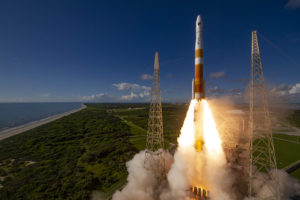The long-awaited markup of the Senate Appropriations Defense Subcommittee’s fiscal year 2020 defense spending bill fully funds or provides more money for space-related efforts, countering cuts made in the House-passed version and setting up areas of contention before a conference bill is agreed upon.
SAC-D leadership released a summary of its FY ’20 markup Sept. 10 upon the bill’s approval by the subcommittee Tuesday morning. The bill provides $622.5 billion in base Department of Defense funding, along with over $70 billion for Overseas Contingency Operations (OCO) funding and $1.7 billion in emergency funding (Defense Daily, Sept. 10).

While the full bill will not be released until after the full Senate Appropriations Committee markup Sept. 12, the summary includes several items related to space procurement and research-and-development funds.
If passed, the Senate Appropriations Committee’s bill would fully fund the Air Force’s $1.2 billion request for future National Security Space Launch (NSSL) efforts. The summary included “a general provision to protect the Air Force launch development and launch service procurement schedules,” apparently countering language included in the House version of the FY ‘2020 National Defense Authorization Act (NDAA) that directs the Air Force to include more flexibility in its ongoing competition for future NSSL launches, called the launch services procurement (LSP) program.
House Armed Services Committee (HASC) Chair Adam Smith (D-Wash.) has expressed frustration several times over perceived unfair bias in the Air Force’s LSP program. The House-passed FY ’20 NDAA included a provision for the Air Force to create more opportunities for new entrants to compete in the program, and included an additional $500 million to go to a prospective competitor who may win the Phase 2 contract without having received prior government subsidies to build a new rocket (Defense Daily, June 10).
Northrop Grumman Innovation Systems [NOC], Blue Origin, United Launch Alliance — a joint launch venture between Boeing [BA] and Lockheed Martin [LMT]–were each awarded an October 2018 contract to receive Air Force funds to help develop new launch vehicles (Defense Daily, Oct. 10, 2018). Space X has also indicated it plans to compete for the launch services program. Blue Origin initiated a lawsuit against the Air Force in August, claiming the request for proposals was biased against new entrants to the national security launch field (Defense Daily, Aug. 12).
Another item related to space launch is a plan to create a new budget line for “Tactically Responsive Launch to ensure the Air Force devotes adequate resources to venture class launch services,” the summary said. Additional details were not immediately provided to Defense Daily.
Meanwhile, the committee also creates a new procurement line for Electro Optical/Infrared (EO/IR) Weather “for procurement of a weather sensor,” the summary said. Further details on what this new weather sensor would entail were not immediately provided to Defense Daily.
The markup includes the Air Force’s full request for its next-generation Overhead Persistent Infrared (OPIR) systems, in development by Lockheed Martin, and tacks on an extra $536 million to accelerate the program. The service had requested $1.395 billion in research, development, test and evaluation (RDT&E) funds and $234 billion in procurement funds for the effort.
The House Appropriations Committee’s passed bill decreased the Air Force’s original request and only included $1.19 billion for the next-gen OPIR program. The bill stipulated in the draft defense bill released in May that not more than 50 percent of the funds appropriated may be obligated or expended by the DoD for the effort until lawmakers receive a report outlining how the proposed Space Development Agency (SDA) will interact with the Air Force (Defense Daily, May 14).
The subcommittee provided $108 million to the Missile Defense Agency (MDA) for the Hypersonic and Ballistic Tracking Space Sensor program, and over $237 million for the MDA to study hypersonic defense systems. The summary did not include any language related to the Space Development Agency, for which the Defense Department had requested nearly $45 million in O&M costs for 2020, as well as $105 million for the nascent agency to build a next-generation space-based sensor layer architecture.
SAC Chairman Richard Shelby (R-Ala.) said Tuesday that the committee supports the Pentagon’s request for Space Force-related operations and maintenance funds, but did not provide a proposed amount. The FY ’20 Presidential Budget request included $72 million to stand up a new sixth branch of the U.S. Armed Forces dedicated to space. The House Appropriations Committee’s spending bill included $15 million for the Air Force to “study” the proposed Space Force.